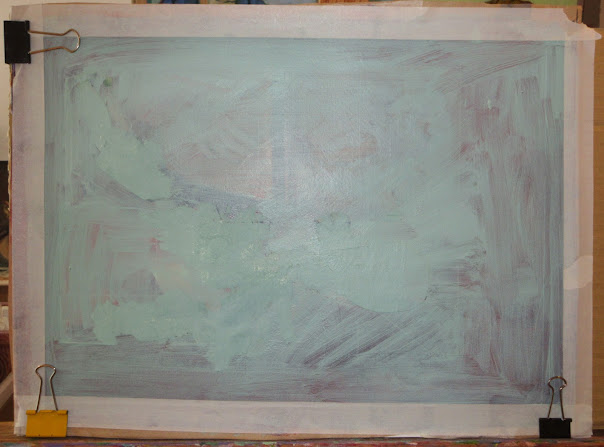Continuing the Empty Frame Series, we're hooking up in this post with Thomas Worthington ("Worth") Whittredge. He's another of those 19th century American artists who lived out the stereotypical story of the rural, semi-educated kid who was driven to draw and paint and managed to do so despite family discouragement. And paint he did – becoming a pal of Sanford Gifford, who kicked off this series, and earning fame in East Coast artists' circles.
How could I resist choosing this framed photo as the basis for my Worth Whittredge portrait?
Continuing my exploration of various artists' materials, I chose to work with fine-tipped art markers, as did this artist in "Portrait Revolution."
I set to work, realizing I'd need to carefully scale up this framed portrait.
On the slick paper I'd intended just for a draft, these markers were a tricky medium – slick on the one hand, indelible on the other, and the merest accidental touch-down would leave a definite mark. I sensed that "Worth" was finding it all a little boring, too, as he tried to refrain from squirming.
Here's the final portrait, "Framed (For the most part) – Worthington Whittredge".
Now, on to the Whittredge painting I selected – "The Woods", a close view quite unlike his better known expansive landscapes.
From my photo files, I found a somewhat comparable scene, taken along a trail in the woodlands just south of Deep Cove.
I'd been browsing through some of my cherished art books and decided that for summer camp fun, I'd work in a semi-abstract style reminiscent of one of my original heroes in paint, 20th century American artist and teacher Edward Betts.
As I looked at the 1982 inscription inside the cover, I remembered feeling a pang then – that if I'd stayed in Illinois (though dying to bust out of it at the age of 18), I might have had him as a teacher. He also had a great connection to Maine, and his book is full of his paintings and drawings (and other artists') of rocky shorelines and granite quarries.
I made a start and found it uninspiring.
Searching on-line, I came across this more relevant example of Betts' work – just some of it shown in part of a frame!! Was it meant to be?
Using acrylic medium, I papered over the Bad Betts with swirling rice paper. I then cut up an old membership card to use, instead of a brush, to pull small puddles of paint across the heavily textured surface.
Here's the finale: "Catching the Moonlight on Deep Cove Trail" – Empty Frame Series, copyright 2023.
I've always kept in mind the gist of Betts' answer to the question, "How do you know when a painting is finished?" He wrote:
(It is important that you) "keep yourself attuned to what is happening on the painting surface. You must always be ready to act in answer to what arises there, to recognize and grasp those elements that suggest the route to order and structure in the painting. Once the control image has been found, the act of painting becomes more purposeful. Finally, a point is reached when you find yourself fussing over unimportant little things, when you have said all you wanted to say, when nothing can be added or subtracted without upsetting the picture's overall organization. At that point, your painting is finished."















No comments:
Post a Comment